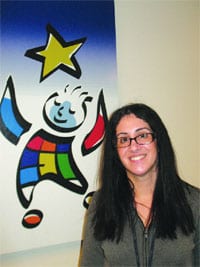Making Contact With Autistic Children, Early Intervention Is Key
With claims linking autism with childhood immunizations beginning to die down — at least in some quarters — medical science isn’t much closer to wrapping its arms around what causes this common developmental disorder.
Or, for that matter, why the incidence seems to be on the rise.
Today, it is estimated that one in every 110 children — and about 1 in 70 boys — is diagnosed with autism, making it more common than childhood cancer, juvenile diabetes, and pediatric AIDS combined, according to the national advocacy organization Autism Speaks. An estimated 1.5 million individuals in the U.S. and tens of millions worldwide are affected by autism.
Government statistics suggest the prevalence of autism is increasing, perhaps between 10{06cf2b9696b159f874511d23dbc893eb1ac83014175ed30550cfff22781411e5} and 17{06cf2b9696b159f874511d23dbc893eb1ac83014175ed30550cfff22781411e5} annually. Although no solid explanation has emerged for this increase, some have suggested improved diagnosis as a factor — but that theory has holes.
“At the beginning, we were saying that the increase was due to redefining other children with disabilities with this diagnosis,” said Dr. Cheryl Tierney, a developmental and behavioral pediatrician with Baystate Health. “But there does seem to be an increased incidence, and we don’t have a great explanation.”
Doctors do, however, have a better-than-ever handle on the nuances of autism and the resources needed to care for children with the disorder.
“Autism is a neurodevelopmental disorder that involves communication and the social domain of development,” Tierney told The Healthcare News. “A child with autism will have difficulty understanding language, expressing himself verbally, and relating to others. Also, but not always, there’s a stereotypical repetitive behavior — repetitive hand flapping, spinning, repetitive sounds or body movements.”
Indeed, the symptoms of autism can manifest as atypical behavior in several areas of a child’s development, including:
• Communication. Language might develop slowly or not at all, and the child is more likely to use gestures than words to express himself. Often, a child who has developed some language skills might regress and lose some of it.
“Language isn’t just delayed; it’s atypically developing,” Tierney explained. “Often, but not always, a child may have a different understanding of the purpose of language.
“They may repeat what you say — that’s called echolalia — but won’t understand that words mean something to get a message across,” she continued. “They may say a lot of things, but not understand what they’re saying.”
Eye contact — actually, lack of it — can be a telling sign of autism as well, Tierney said.
“Kids with autism often do not make or sustain eye contact,” she explained. “They might look at you briefly, but not ‘lock gaze,’ as we call it. They might catch your eye, but typically developing kids really lock your gaze; they really look at you to get their message across. Kids with autism have much less of that, or none of it.”
• Social interaction. An autistic child may spend much time alone or show little interest in making friends. Even the way they interact with those close to them on a daily basis can be much different than typical children.
“Children playing typically want the parent or caregiver to join in and play, to share the enjoyment; they get excited about what they did and try to include the parent in that excitement,” Tierney said. Autistic children, on the other hand, “usually get excited, but for themselves, not to include someone else.”
• Sensory impairment. The child might have unusual reactions to physical sensations, or be overly sensitive to touch.
Other behavioral signs might emerge as well. The child may become either overactive or very passive, launch frequent tantrums for no apparent reason, or become obsessed with a single item, idea, or person. Also common are a lack of common sense or aggressive or self-injurious behavior.
This month, The Healthcare News takes a look at autism, why children suspected of being autistic should be diagnosed as soon as possible, and what services are available to help them live typical lives.
Searching for a Cause
All those questions have been obscured in some circles by the vaccination controversy, which still sparks emotional responses from many parents who believe that a mercury preservative used in immunizations has been responsible for a rise in autism in young people. But those voices are raised less often these days.
“Immunization is not the cause,” Tierney said, noting that the controversy has largely died down. “We used to see parents not immunizing, but we’re not seeing that anymore, so the word is out. Parents may ask questions — ‘are you sure?’ — but as far as parents saying, ‘there’s no way I’m immunizing,’ we’re not seeing that anymore. The autism rate of the population that doesn’t immunize is the same rate as the immunizing population.”
The controversy might have reached a turning point last year when Autism Speaks issued a clear public statement minimizing the link between the disorder and thimerosal, the mercury preservative in question.
“Given what the scientific literature tells us today, there is no evidence that thimerosal or the MMR vaccine causes autism,” said Dr. Geri Dawson, the group’s chief science officer, adding that “evidence does not support the theory that vaccines are causing an autism epidemic.”
She allowed for the possibility that reactions to vaccinations might cause autism in a small subset of children, but essentially ruled out vaccines as a major trigger for the disorder. Even so, partly because of parental anxiety, thimerosal is no longer used in vaccines given to children under 6 months old.
An organic mercury compound, thimerosal was used for decades as a preservative in multi-dose vials of some vaccines to keep them from being contaminated when needles were repeatedly inserted into them. It has now been removed from all childhood vaccines except some versions of the flu vaccine.
So what does cause autism? The simple answer is that, in the vast majority of cases, no one really knows.
The more complex answer points toward a potential combination of factors — multiple genetic components that may cause autism on their own or possibly when combined with exposure to as-yet-undetermined environmental factors. The timing of exposure during the child’s development may also play a role in the development of the disorder.
“There is this thinking that there’s a genetic predisposition,” Tierney said, “and some environmental factor triggers the expression of the disorder, and that’s under active investigation now.”
According to Autism Speaks, a small number of cases have been linked to genetic disorders such as fragile X, tuberous sclerosis, and Angelman’s syndrome, as well as exposure to certain infectious or chemical agents during pregnancy.
Many theories are being investigated, Tierney noted, and some regimens have been debunked by the medical establishment — for instance, switching to a gluten-free diet. “The jury’s still out, but it doesn’t look like it’s very helpful, and it doesn’t change the core symptoms.” The same goes for hyperbaric oxygen therapy, which she said can actually be dangerous.
Tierney didn’t rule out all outside-the-mainstream treatments, but she did recommend getting the advice of a doctor who is open to options. “If you want to look for alternative therapies for your kid, consult a physician who’s willing to work with you and give you guidance and support,” she said. “It’s fine to try things as long as you’re not doing something that’s shown to be harmful.”
First Steps
While the causes of autism may not be well-understood, plenty of research points to the importance of diagnosing it as early as possible and getting the autistic child into a specialized program. Experts in the field encourage parents and pediatricians not to ignore the commonly recognized communication and social-development signs and to have children that manifest them tested, even though roughly 80{06cf2b9696b159f874511d23dbc893eb1ac83014175ed30550cfff22781411e5} of children so tested do not turn out to be autistic.
“All the research shows that the best outcomes are diagnosed early,” Tierney said. “The best situation would be a child around 18 months or so, when you’d begin to suspect some of these problems, and you refer him to a specialist, who would then be able to figure out if you’re truly dealing with an autism-spectrum disorder. That person would be able to make a referral for specialized services.”
Nancy Lunden runs such a service, as director of the May Center for Intervention and Specialty Services in West Springfield. Programs like the May — others in Western Mass. include Beacon Services in Springfield, REACH in South Deerfield, and the Pediatric Development Center in Pittsfield — receive public funding and provide day services for autistic children until age 3, when public schools take over the responsibility.
“We all follow the same regulations set by the Department of Public Health,” Lunden said. “Some agencies do things a little differently, but we all have to use the same eligibility tools that get a child in the door.”
And getting him or her in the door early is critical, she noted. “All the research says that the earlier a child receives intensive services, the more gains the child will make.”
Tierney said Massachusetts has an effective framework in place to identify autistic kids and get them the help they need. “Hopefully they’re diagnosed early — before age 2,” she said. “Many early-intervention providers in this area are good about picking up children they think have autism and referring them for a diagnosis.”
Programs like the May and the others in the Pioneer Valley use different treatment methods, which is why parents should do their homework and consult the child’s doctor on what type of program is the best fit. But all include elements of speech therapy, occupational therapy, play groups, and other services, and often it adds up to a long day for the child, Lunden said. “It’s like having a job,” she said. “Sometimes they can fit in a nap.”
Tierney agreed that treatment is effective if delivered early and intensively, as soon as a diagnosis is made, noting that kids might spend 20 to 40 hours a week in specialized autism programs during the preschool years.
“Sometimes parents are reluctant to expose children to so many hours of therapy, thinking it’s too much for them,” she said. “But the research is very strong that, if you can get a child to tolerate the hours, the outcomes are better.”
That’s why she stressed the importance of recognizing the signs and having a young child tested right away instead of ignoring the symptoms of autism and hoping they disappear. After all, testing is a win-win, she said; either the child does not have autism and the parents are relieved, or they know they got a head start on needed treatment.
“If families have any concerns, it’s better to have the child evaluated and be reassured than to find out later that they had these concerns and didn’t do anything about it,” she said. “There’s a lot of guilt involved in asking, ‘what would have happened had I come in earlier?’”
After all, parents want to do what’s best for their kids. That may be the most typical behavior of all.


